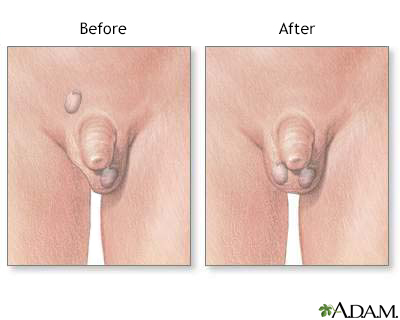Pregnancy SmartSiteTM
Orchidopexy; Inguinal orchidopexy; Orchiopexy; Repair of undescended testicle; Cryptorchidism repair DefinitionUndescended testicle repair is surgery to correct testicles that have not dropped down into the correct position in the scrotum. DescriptionThe testicles develop in the infant's abdomen as the baby grows in the womb. They drop down into the scrotum in the last months before birth. In some cases, one or both testicles do not drop into the correct position. In about one half of babies, the testicles will descend within the first year of life without treatment. Undescended testicle repair surgery is recommended for males whose testicles do not descend on their own. The surgery is done while the child is asleep (unconscious) and pain-free under general anesthesia. The surgeon makes a cut in the groin. This is where most undescended testes are located. After finding the cord that holds the testis in the scrotum, the surgeon unties it from the tissue around it. This allows the cord to extend to its full length. A small cut is made in the scrotum, and a pouch is created. The testicle is pulled down into the scrotum and stitched into place. Stitches are used to close the surgical cuts. In some cases, the procedure can be done laparoscopically. This involves smaller surgical cuts. When the testicle is located very high, correction may require two stages. The separate surgeries are done several months apart. Why the Procedure Is PerformedThis surgery is recommended for infants older than 1 year whose testicles have not descended into the scrotum (cryptorchidism). An undescended testicle is different from a "retractile" testicle. In this condition, the testicle drops into the scrotum and then pulls back. Retractile testicles do not need surgery. RisksRisks of any anesthesia are:
Risks of any surgery are:
Risks of this surgery include:
Before the ProcedureTell your surgeon or nurse if:
During the week before your surgery:
After the ProcedureUndescended testicle repair is successful in most cases. A small percentage of men will have fertility problems. Men who have had undescended testicles should do monthly self-exams for the rest of their lives to look for possible tumors. Men with undescended testes have higher rates of testicular cancer than those with normal testicle development, even if they have a fully descended testicle on the other side. There is also a higher risk for testicular cancer in the other testicle that descended normally. Bringing the testicles down will make it easier to monitor for tumor growth in the future. Outlook (Prognosis)The surgery may be done on an outpatient basis. Bed rest is recommended for the first 2 to 3 days. Avoid strenuous activity, including bicycling, for at least 1 month. ReferencesBarthold JS, Hagerty JA. Etiology, diagnosis, and management of the undescended testis. In: Partin AW, Domochowski RR, Kavoussi LR, Peters CA, eds. Campbell-Walsh-Wein Urology. 12th ed. Philadelphia, PA: Elsevier; 2021:chap 46. Di Carlo HN, Crigger CB. Disorders and anomalies of the scrotal contents. In: Kliegman RM, St. Geme JW, Blum NJ, et al, eds. Nelson Textbook of Pediatrics. 22nd ed. Philadelphia, PA: Elsevier; 2025:chap 582. Eftekharzadeh S, Weaver J, Srinivasan AK. Laparoscopic orchiopexy. In: Bishoff JT, Kavoussi LR, Kavoussi N, Bishoff T, eds. Atlas of Laparoscopic and Robotic Urologic Surgery. 4th ed. Philadelphia, PA: Elsevier; 2023:chap 39. | ||
| ||
Review Date: 1/1/2025 Reviewed By: Kelly L. Stratton, MD, FACS, Associate Professor, Department of Urology, University of Oklahoma Health Sciences Center, Oklahoma City, OK. Also reviewed by David C. Dugdale, MD, Medical Director, Brenda Conaway, Editorial Director, and the A.D.A.M. Editorial team. View References The information provided herein should not be used during any medical emergency or for the diagnosis or treatment of any medical condition. A licensed medical professional should be consulted for diagnosis and treatment of any and all medical conditions. Links to other sites are provided for information only -- they do not constitute endorsements of those other sites. No warranty of any kind, either expressed or implied, is made as to the accuracy, reliability, timeliness, or correctness of any translations made by a third-party service of the information provided herein into any other language. © 1997- A.D.A.M., a business unit of Ebix, Inc. Any duplication or distribution of the information contained herein is strictly prohibited. | ||


 Male reproductive ...
Male reproductive ... Before and after t...
Before and after t...
